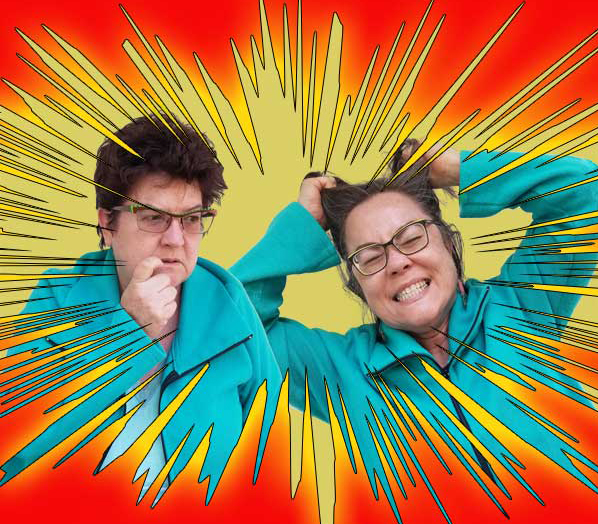This is Kris, back with another Tech Tuesday installment. There will be times, trust me on this one, when your Photoshop Elements tools will just start behaving badly. It’s really not your fault. Well, actually you probably clicked something you shouldn’t have, but that’s not the point. The question is how to fix it. Here are a couple of interesting examples of what can go wrong and some solutions. Skip to the end for the if-all-else-fails fix.
Color Picker Slider Bar Doesn’t Show All the Colors
Let’s say you want to change your color swatch, so you click on the foreground color to open the Color Picker dialog box. Yes, the color swatch is not exactly a tool, but it is located in the toolbar. Anyway, you notice that the colors in the slider bar are all funky. In the example below (purple outline), there are just shades of the current color (here yellow). Take a look at the radio buttons to the side of the slider bar. You’ll see that “B” is selected (purple arrow). This is around the time when you’re probably wondering what these letters stand for. H, S, and B stand for Hue, Saturation, and Brightness, in other words the way the human eye sees color. The second set of letters, RGB, stand for red, green, and blue, or the way computer monitors display color. Since this example is on blue, the slider bar is completely different.
![]()
In the example below, you’ll see that H has been selected (purple arrow). The hue is being used, so the slider bar (purple outline) shows all the colors we are used to seeing. You’re back in business!
![]()
Can’t see Brush Tool
Have you ever lost sight of your brush tool? You’ve tapped the Caps Lock key, which is the shortcut key to change the cursor to the crosshair, but when you tap the Caps Lock key again, you still don’t see the cursor? Most likely your Brush tool is simply too large. In the example below, I zoomed way out on my image to finally locate the Brush tool cursor. It was way too big! (Your Brush tool is not this dark. I made a thick circle so you could see it.)
![]()
To fix this issue, you can simply tap on the left bracket key “[” until the cursor comes into view on the image, OR you can reset your Brush tool by clicking on the More arrow (purple arrow) in the Brush tool options bar and choosing “Reset Tool.”
![]()
When All Else Fails
One time, I could not show the bounding box on my Move tool. I use those bounding boxes all the time. I was so frustrated that I was going to call Adobe for help (but who has all those hours to wait on the phone?), until I realized that the answer just might lie in my preferences. It doesn’t matter what your problem is. If you have tried all the standard best practices to fix an issue, like the examples above, try and reset your preferences. This will work for a variety of issues, not just fixing your tools.
To open your Preferences dialog box, from the Menu bar click File > Preferences (Mac users = click on Adobe Photoshop Elements Editor > Preferences). Make sure you have General selected (red arrow). Click on the button that says “Reset Preferences on next launch,” (blue arrow). Now click OK ( green arrow).
![]()
Once you close the dialog box, close Photoshop Elements. Open the program again, in other words “launch” the program. All your preferences have been reset to the factory default. Doing this will more than likely cure any of the bugs you were experiencing earlier. Many thanks to our former student, Sherri Culver, who experienced a glitch in PSE she just couldn’t fix. This is what reminded me of the when-all-else-fails solution. Good luck, everyone!
By the way, our next series of Photoshop Elements classes start on Sep 9. Registration opens on Aug 12. Click here for more information.

